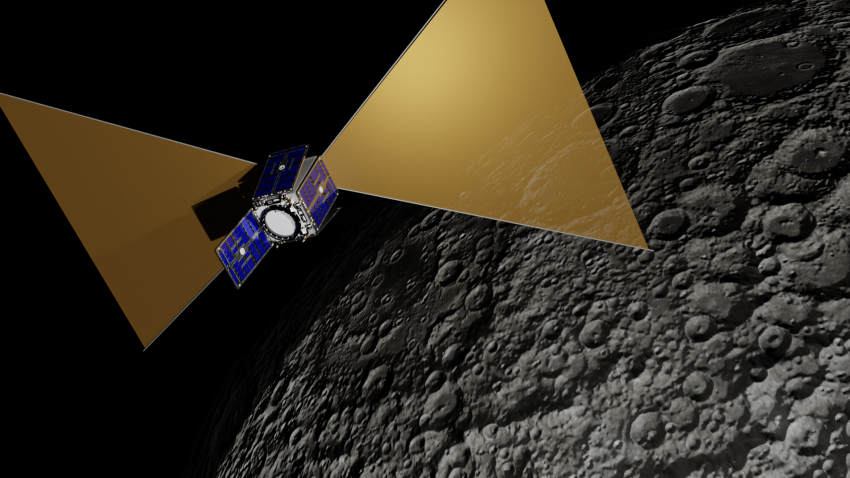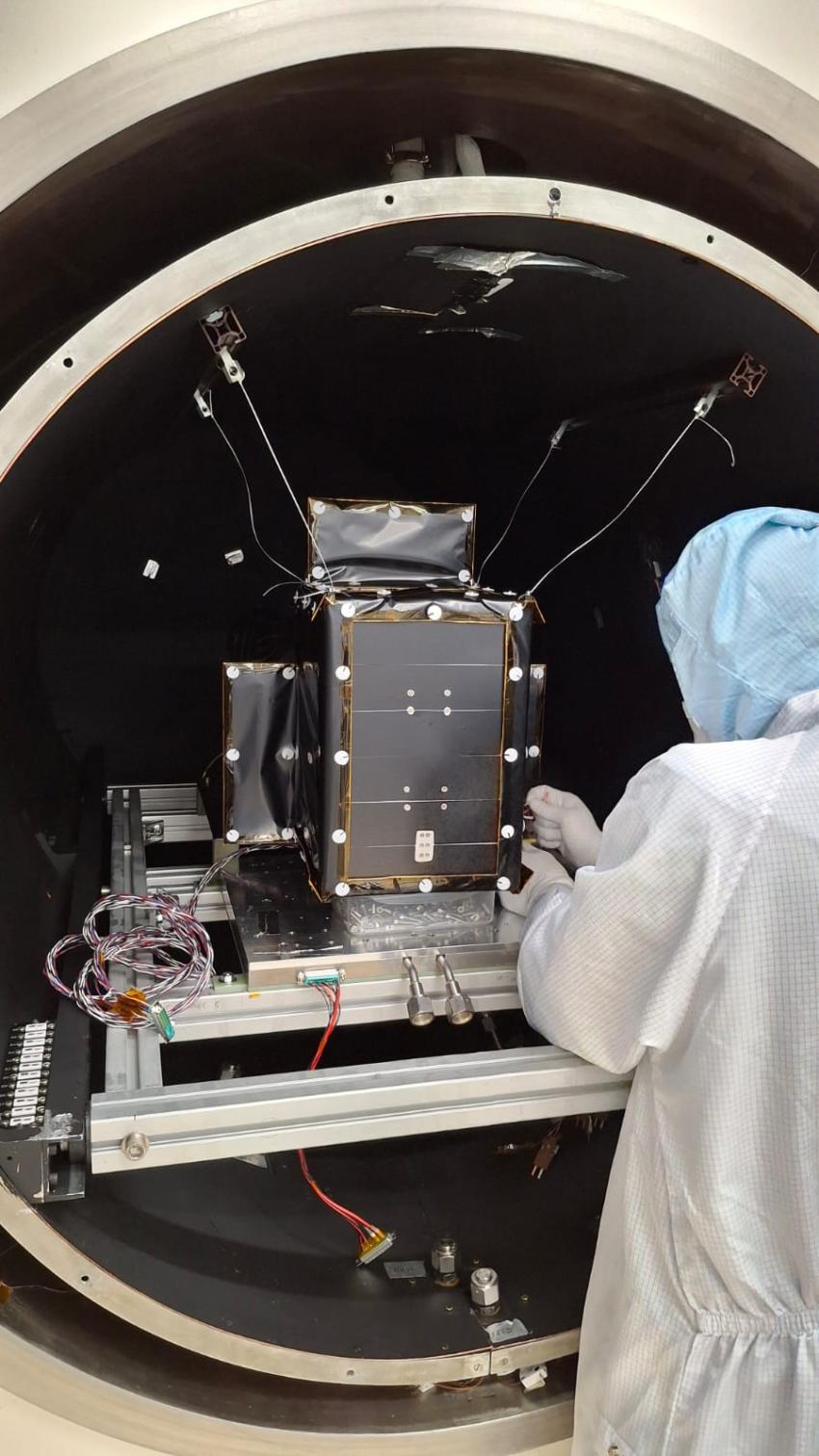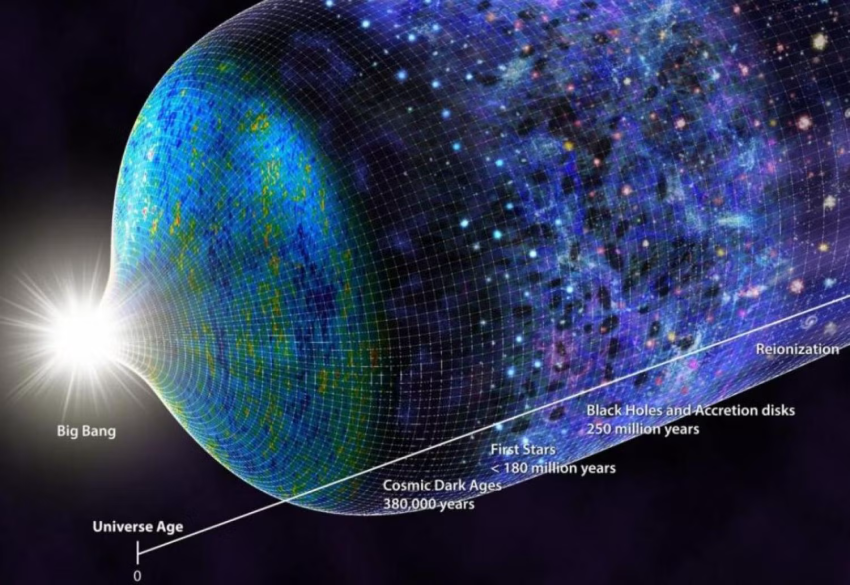Astronomers want to unlock the secrets of the 'Cosmic Dawn' by sending a miniature spacecraft to listen out for an "ancient whisper" on the far side of the Moon.
The proposed mission will study the very early universe, right after the Big Bang, when it was still quite dark and empty before the first stars and galaxies appeared.
But to probe the cosmic 'Dark Ages', silence is essential. And Earth is a very 'noisy' place for radio signals, with interference from our atmosphere and all our electronics.
"It's like trying to hear that whisper while a loud concert is playing next door," said Dr Eloy de Lera Acedo, who is presenting the proposal today at the Royal Astronomical Society’s National Astronomy Meeting 2025 in Durham.
"This makes it really hard to pick up those faint signals from billions of years ago. To detect a special radio signal that comes from hydrogen – the first, most basic and most abundant chemical element – in the early universe, we need it to be quiet.
"That's why we're proposing to send a small satellite to orbit the Moon and detect a signal which could hold clues about how everything began and how structures like galaxies eventually formed."
The UK-led CosmoCube mission would observe from the far side of the Moon, which acts like a giant shield, blocking out all the radio noise from Earth.
This would create a clear, quiet spot to "listen" for an "ancient whisper" and learn more about the universe's Dark Ages and Cosmic Dawn – periods that are currently largely unexplored.
"By doing this, CosmoCube aims to help us better understand how our universe transformed from a simple, dark state to the complex, light-filled cosmos we see today, with all its stars and galaxies," said de Lera Acedo, head of Cavendish Radio Astronomy and Cosmology at the University of Cambridge.
"Crucially, it will also help scientists investigate the mysterious dark matter and its role in shaping these cosmic structures."
CosmoCube will feature a precision-calibrated, low-power radio radiometer operating from a low-cost satellite platform in lunar orbit. It would operate at low frequencies (10–100 MHz), engineered to detect extremely faint signals amidst a sea of noise.
The mission could help shed light on the Hubble tension, which refers to the discrepancy in the measured expansion rate of the universe, specifically between the value based on observations of the early universe and value related to observations of the local universe.
It may also provide insights into dark matter-baryon interactions (potential, non-gravitational interactions between dark matter particles and ordinary matter) and the physics of the early universe.
This so-called 'Dark Ages' period is one of the last unexplored frontiers in observational cosmology. The pre-stellar epoch offers a pristine view into the formation of structure, the properties of dark matter, and early cosmic evolution.
"It's incredible how far these radio waves have travelled, now arriving with news of the universe's history," said fellow CosmoCube researcher Professor David Bacon, from the University of Portsmouth.
"The next step is to go to the quieter side of the Moon to hear that news."
Cosmo Cube is supported under the UK Space Agency's Science Bilateral Programme and is being developed by a UK-led international consortium with researchers based at the University of Cambridge, University of Portsmouth and STFC RAL Space.
Instrument development is well under way, with functioning lab prototypes and environmental testing taking place and key collaboration with industry partners, such as SSTL Ltd, developing the space platform and mission concept.
The team behind the project are planning for a 4–5 year roadmap to launch, with the goal of reaching lunar orbit before the end of the decade.
ENDS
Media contacts
Sam Tonkin
Royal Astronomical Society
Mob: +44 (0)7802 877 700
Dr Robert Massey
Royal Astronomical Society
Mob: +44 (0)7802 877 699
Megan Eaves
Royal Astronomical Society
Science contacts
Dr Eloy de Lera Acedo
University of Cambridge
Images & captions
Caption: An artist's impression of the UK-led CosmoCube spacecraft, which would orbit be tasked with listening out for an "ancient whisper" from the early universe on the far side of the Moon.
Credit: Nicolo Bernardini (SSTL Ltd) & Kaan Artuc (University of Cambridge)
Caption: A model of the CosmoCube satellite undergoes thermal vacuum tests at the RAL Space facilities.
Credit: Dr Will Grainger, RAL Space
Caption: Depiction of the Dark Ages era of the universe, right after the Big Bang, and before the formation of the first starts and galaxies.
Credit: University of Colorado, Boulder
Further information
The talk 'CosmoCube: Probing the Cosmic Dark Ages with a Miniature Radiometer in Lunar Orbit' will take place at NAM at 16:45 BST on Wednesday 9 July 2025 in room TLC10. Find out more at: https://conference.astro.dur.ac.uk/event/7/contributions/484/
More information about the CosmoCube mission can be found at: https://www.cosmocube.net
Notes for editors
The NAM 2025 conference is principally sponsored by the Royal Astronomical Society and Durham University.
About the Royal Astronomical Society
The Royal Astronomical Society (RAS), founded in 1820, encourages and promotes the study of astronomy, solar-system science, geophysics and closely related branches of science.
The RAS organises scientific meetings, publishes international research and review journals, recognises outstanding achievements by the award of medals and prizes, maintains an extensive library, supports education through grants and outreach activities and represents UK astronomy nationally and internationally. Its more than 4,000 members (Fellows), a third based overseas, include scientific researchers in universities, observatories and laboratories as well as historians of astronomy and others.
The RAS accepts papers for its journals based on the principle of peer review, in which fellow experts on the editorial boards accept the paper as worth considering. The Society issues press releases based on a similar principle, but the organisations and scientists concerned have overall responsibility for their content.
Keep up with the RAS on Instagram, Bluesky, LinkedIn, Facebook and YouTube.
Download the RAS Supermassive podcast
About the Science and Technology Facilities Council
The Science and Technology Facilities Council (STFC), part of UK Research and Innovation (UKRI), is the UK’s largest public funder of research into astronomy and astrophysics, particle and nuclear physics, and space science. We operate five national laboratories across the UK which, supported by a network of additional research facilities, increase our understanding of the world around us and develop innovative technologies in response to pressing scientific and societal issues. We also facilitate UK involvement in a number of international research activities including the ELT, CERN, the James Webb Space Telescope and the Square Kilometre Array Observatory.
About Durham University
Durham University is a globally outstanding centre of teaching and research based in historic Durham City in the UK.
We are a collegiate university committed to inspiring our people to do outstanding things at Durham and in the world.
We conduct research that improves lives globally and we are ranked as a world top 100 university with an international reputation in research and education (QS World University Rankings 2026).
We are a member of the Russell Group of leading research-intensive UK universities and we are consistently ranked as a top five university in national league tables (Times and Sunday Times Good University Guide and The Complete University Guide).
For more information about Durham University visit: www.durham.ac.uk/about/




